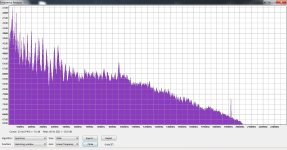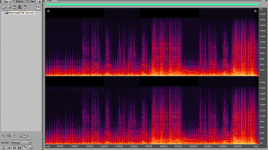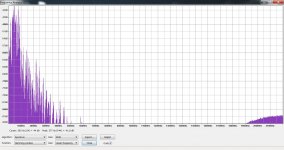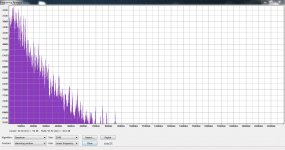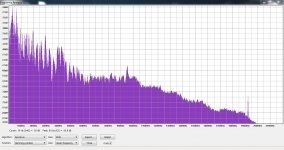Following on from the all the listening tests (and many were disappointed when the last passives one was cut short) I tried to think of something different that might help show differences in components etc.
One criticism that keeps cropping up is the "quality of the hardware" that I use... perhaps its a valid criticism. Another the use of Foobar and the two big big issues... that there are to many downloads involved and to much effort needed to listen to them all. All valid points.
So as a first step to a new and much simpler test I would really appreciate your thoughts on this as a test track. Hit it with all you've got listening wise.
as a first step to a new and much simpler test I would really appreciate your thoughts on this as a test track. Hit it with all you've got listening wise.
https://www.dropbox.com/s/r5tbqnyplhdnuku/New Audio File Test.wav
One criticism that keeps cropping up is the "quality of the hardware" that I use... perhaps its a valid criticism. Another the use of Foobar and the two big big issues... that there are to many downloads involved and to much effort needed to listen to them all. All valid points.
So
https://www.dropbox.com/s/r5tbqnyplhdnuku/New Audio File Test.wav
I repeat my first suggestion, it should not be about using extreme cases to prove a generality as your title states. How about subbing a single plain old Dale 1% resistor for a fashionable one?
I still have not had the time to listen carefully but I did notice some bothersome glitches at regular intervals in the spectrum as others noticed. I saw as much as 12dB difference in very narrow high frequency bands when the midband was an exact match. No idea what analog mechanism could cause this.
I still have not had the time to listen carefully but I did notice some bothersome glitches at regular intervals in the spectrum as others noticed. I saw as much as 12dB difference in very narrow high frequency bands when the midband was an exact match. No idea what analog mechanism could cause this.
Last edited:
I haven't got a Dale 1% resistor 
Seriously though Scott, I follow what you are saying (and can see its that kind of component swap many are interested in) but personally I suspect that we have to determine in the first instance whether or not component changes (subtle or not) are actually distinguishable via this kind of a test. And that means starting "coarse" like the cheapo electrolytics.
I would appreciate an opinion on the file in post #1. Its only a couple of minutes in length.
We need a base line of what is detectable .
Seriously though Scott, I follow what you are saying (and can see its that kind of component swap many are interested in) but personally I suspect that we have to determine in the first instance whether or not component changes (subtle or not) are actually distinguishable via this kind of a test. And that means starting "coarse" like the cheapo electrolytics.
I would appreciate an opinion on the file in post #1. Its only a couple of minutes in length.
We need a base line of what is detectable .
There seems to be an artifact in the audio at 19239 Hz
Thanks for taking a look. OK
Anything else apparent ?
Attachments
Brittle, garbled, metallic.
Thank you. These are just first steps for this one at the moment. Please bear with me on this.
Glad that was helpful.
A little more specific:

In the above, cue points have been added labeled "Nasty" and "Normal"
Track starts out nasty. At 2nd cue point sound is relatively normal. Then goes nasty, normal, nasty to the end.
"Normal" sound is characterized by better low end, less garble smear, and less metallic. Metallic in nasty regions is more than just unmasking by having less low end.
Not at all subtle.
A little more specific:

In the above, cue points have been added labeled "Nasty" and "Normal"
Track starts out nasty. At 2nd cue point sound is relatively normal. Then goes nasty, normal, nasty to the end.
"Normal" sound is characterized by better low end, less garble smear, and less metallic. Metallic in nasty regions is more than just unmasking by having less low end.
Not at all subtle.
I've run some checks and ripped the test track just now as a check and control on a different PC to try and see what was going on. The 19.2kHz is a puzzle BUT it seems to be present on the original CD.
Here are three spectrums of three different CD's. The third is the one in this test. I can't explain what that artifact is in this case, but it genuinely seems to be present on the original CD. All three CD's were ripped under identical conditions using "Exact Audio Copy" and imported into Audacity to view the spectrum. I have coincidently seen that same effect on my Acer laptop when using it to record via its A/D convertor and that anomaly pointed out to me some weeks ago. That was proved at the time beyond doubt to be an artefact of the Acer. There is no such issue with the Dell used to do the three rips above.
Why there should be a similar line on this particular CD I can not answer.
The good news is that I feel the thread and test is still very valid.
Your comments on the file in post #1 are still needed
Here are three spectrums of three different CD's. The third is the one in this test. I can't explain what that artifact is in this case, but it genuinely seems to be present on the original CD. All three CD's were ripped under identical conditions using "Exact Audio Copy" and imported into Audacity to view the spectrum. I have coincidently seen that same effect on my Acer laptop when using it to record via its A/D convertor and that anomaly pointed out to me some weeks ago. That was proved at the time beyond doubt to be an artefact of the Acer. There is no such issue with the Dell used to do the three rips above.
Why there should be a similar line on this particular CD I can not answer.
The good news is that I feel the thread and test is still very valid.
Your comments on the file in post #1 are still needed
Attachments
I've run some checks and ripped the test track just now as a check and control on a different PC to try and see what was going on. The 19.2kHz is a puzzle BUT it seems to be present on the original CD.
Would you post a sample of original data, like 20 - 30s.
Would you post a sample of original data, like 20 - 30s.
You should have it now
Glad that was helpful.
A little more specific:
View attachment 398016
In the above, cue points have been added labeled "Nasty" and "Normal"
Track starts out nasty. At 2nd cue point sound is relatively normal. Then goes nasty, normal, nasty to the end.
"Normal" sound is characterized by better low end, less garble smear, and less metallic. Metallic in nasty regions is more than just unmasking by having less low end.
Not at all subtle.
This is a hugely interesting result
Can I just be sure what are meaning. Track starts nasty... OK. How long does that "nasty" last ? You have marked a point around 40 seconds in. Is it OK up to that point or does it start nasty and gradually get better ?
Sorry... I'm just not 100% clear what you meant there
Not picking up on Barleywater's nasty and nice cues, but this is the sort of track I use for assessing at the finer end of tweaking a system capability - a normal setup will show "Brittle, garbled, metallic" very easily here.
What I aim for is to be able to play this at room pounding levels, particularly the chorus section where all the instruments come in, and the sound to remain fully consistent, that none of the above adjectives apply. There is plenty of reverb, which is often hard for systems to reproduce correctly, creates a messy sound when the system is not up to scratch. So - from my POV this is very good material for testing, particularly overall system integrity.
What I aim for is to be able to play this at room pounding levels, particularly the chorus section where all the instruments come in, and the sound to remain fully consistent, that none of the above adjectives apply. There is plenty of reverb, which is often hard for systems to reproduce correctly, creates a messy sound when the system is not up to scratch. So - from my POV this is very good material for testing, particularly overall system integrity.
Last edited:
Actually, I'm running the track on repeat, and the more I listen to it the better I feel it is for testing, the high frequency and low level content is near ideal for sorting out the finer aspects - you should be able to run this at deafening levels, and get more out of it each time ...
Three tracks I use for testing are Leann Rimes - Soon. The Corrs - Somebody for someone. Mandisa - Unrestained (this is a gospel piece if that's not your thing).
All three tracks obviously use a reasonable amount of compression, but they all start off slow and build up towards the end with lots of layered voices/instruments. They are all recorded well and sound great when delivered on a system with excellent clarity and resolution. Some bits of some of the tracks will take your ears off, the sibilants on Soon for example, if the treble isn't doing what it should and the forward highly compressed nature of Unrestrained will blow up in your face if the speakers are too forwards . All three tracks should throw a huge sound stage, with pin point central images if done right. The bass should never draw attention to itself.
I like your track Mooley, I'm not 100% sure what the point of the thread is. I guess we all have different ideas of what a perfect test track is, but I find yours a bit depressing if that's important. We all probably have different things that we like to hear done 'right', but I think most people would agree however that one thing we probably all like to hear is massed voices and heavily layered instruments within a very spacious mix. I don't much mind the genre providing it can do that.
Then there are other tracks that just sound really good, but aren't necessarily that demanding of a system, like Stacy Kents interpretation of Isn't it a lovely day.
One thing I'd point out Mooley, is that your track is apparently 48kHz, which clearly isn't native to the CD it is on. Maybe this is why you're getting a spike at high frequencies, if some processing somewhere is going on.
All three tracks obviously use a reasonable amount of compression, but they all start off slow and build up towards the end with lots of layered voices/instruments. They are all recorded well and sound great when delivered on a system with excellent clarity and resolution. Some bits of some of the tracks will take your ears off, the sibilants on Soon for example, if the treble isn't doing what it should and the forward highly compressed nature of Unrestrained will blow up in your face if the speakers are too forwards . All three tracks should throw a huge sound stage, with pin point central images if done right. The bass should never draw attention to itself.
I like your track Mooley, I'm not 100% sure what the point of the thread is. I guess we all have different ideas of what a perfect test track is, but I find yours a bit depressing if that's important. We all probably have different things that we like to hear done 'right', but I think most people would agree however that one thing we probably all like to hear is massed voices and heavily layered instruments within a very spacious mix. I don't much mind the genre providing it can do that.
Then there are other tracks that just sound really good, but aren't necessarily that demanding of a system, like Stacy Kents interpretation of Isn't it a lovely day.
One thing I'd point out Mooley, is that your track is apparently 48kHz, which clearly isn't native to the CD it is on. Maybe this is why you're getting a spike at high frequencies, if some processing somewhere is going on.
Different types of tracks highlight different things - I use plenty of 'terrible' recordings, things which sound hideous on 95% of systems, because they emphasise precisely what a system is doing wrong. Like using a small, intense, highly concentrated light source on a PCB, to see exactly where there is a break in a trace - it can't be seen otherwise, yet something is definitely wrong ...
- Status
- This old topic is closed. If you want to reopen this topic, contact a moderator using the "Report Post" button.
- Home
- General Interest
- Everything Else
- Component audibility. Fact or fiction ?
